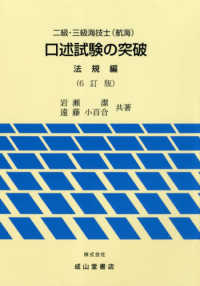Full Description
The ever-increasing interest in the spine and its pathology is not surprising. Acting as the main support of an erect posture unique in the animal kingdom, the human spine is, owing to its numerous articulations, at the same time a supple structure that can respond to the many stresses which are put on it. Constant movement is necessary to preserve its function, but regular and well- is also essential. The high frequency of spinal disorders result- positioned rest ing from misuse is easily explained by day-to-day reality. Among the disorders that result from misuse of the spine, herniated disk, leading to radicular compression, is one of the most frequent. New tech- niques, less invasive and yielding more precise information, have been pro- gressively developed for the diagnosis of this disease and at the same time new methods of treatment have appeared, giving us a much broader range of choices and decisions to make. In the face of this evolving, complex situation, a multidisciplinary team from Strasbourg decided to clarify the topic.
A single man's experience, what- ever his qualities, would certainly have been insufficient and the necessarily limited views of a single speciality would also have been a handicap. This re- markable work is thus the result of collaboration between clinical and inter- ventional radiologists and a neurosurgeon.
Contents
Computed Tomography.- Cervical Disk Herniations.- Clinical Study.- Clinical Signs of Cervicobrachial Neuralgia.- Clinical Examination.- Clinical Types.- Differential Diagnosis.- Etiology of Cervicobrachial Neuralgia.- Soft Disk Herniation.- Definition.- Mechanisms.- Spontaneous Evolution.- Anatomy of the Lower Cervical Spine.- Spinal Canal.- Spinal Cord and Meninges.- Intervertebral Disk.- Epidural Space.- Cervical Spinal Nerves.- Topography of Cervical Roots.- CT Scanning Techniques.- Parameters.- Sections.- Intravenous Injection of Contrast Medium.- Examination.- Radioanatomy.- Foraminal Plane.- Diskal Plane.- Pedicular Plane.- Radiographic Investigation of Soft Cervical Disk Herniations.- Conventional Investigations.- Plain Films.- Myelography with Nonionic Water-soluble Contrast Media.- Cervical Diskography.- CT Signs of Cervical Herniations.- Stasis of the Foraminal Veins: The Basic and Pathognomic Sign.- Cervical Herniation.- Other Types of Herniation.- Interpretation of CT Scans.- Herniation and Arthrosis.- Younger People.- Older People.- Cervical Arthrotic Myelopathy.- Evolution of Unoperated Soft Disk Herniations.- Differential Diagnosis.- Magnetic Resonance Imaging.- Cervical Chemonucleolysis.- Patient Selection.- Techniques: Diskography.- Positioning of Patient.- Disk Puncture.- Diskography.- Chemonucleolysis.- Postdiskography CT.- Results after Chemonucleolysis.- Clinical Findings.- CT Appearance.- In Conclusion.- Conclusion.- Thoracic Disk Herniations.- Clinical Findings.- Surgery.- CT Scans and MRI.- Lumbar Disk Herniations.- Clinical Findings.- Medical History.- Physical Examination.- Atypical Sciatica.- Hyperalgesic Sciatica.- Recurrent Alternating Sciatica.- Cauda Equina Syndrome.- Sciatica with a Motor Deficit.- Sciatica with Lumbar Spinal Stenosis.- Sciatica with a Narrow Lateral Recess.- Femoral Sciatica.- Incomplete Sciatica.- Mild Sciatic Pain.- Radiculalgias at Other Sites.- Refractory Sciatica.- "Symptomatic" Sciatica.- Pathogenesis.- Development of Lumbar Disks.- Embryo and Fetus.- Child.- Anatomy of Adult Disk.- Nucleus Pulposus.- Anulus Fibrosus.- Vertebral Cartilaginous Plates.- Vascularization and Innervation.- Histology.- Biochemistry.- Collagen.- Proteoglycans.- Water and Solutes.- Enzymes.- Disk Aging.- Biomechanics of the Lumbar Disk.- Individual Physiological Roles of Disk Components.- Physiological Role of Disk as Functional Unit.- Structural Deterioration of Lumbar Disk.- Mechanisms of Onset.- Anatomic Alterations: Genesis of Disk Herniation.- Biomechanical Consequences of Disk Degeneration.- Radiologic Examinations.- Routine Radiographs.- Myelography.- Lumbar Phlebography.- Epidurography.- Diskography.- Normal Diskogram.- Disk Herniation.- Degenerate Disks.- CT.- Magnetic Resonance Imaging (MRI).- Postdiskography CT.- CT: Anatomic Aspects.- Section Through the Disk.- Section Through the Upper Portion of the Vertebral Body.- Section Through the Midportion of the Vertebral Body.- Section Through the Intervertebral Foramen.- The Paraspinal Region.- Paravertebral Muscles.- The Extraspinal Course of the Lumbosacral Roots.- The Ascending Lumbar Veins.- Bowel.- Kidneys and Ureters.- Consequences for the Nervous Structures.- Computed Tomography Technique.- CT Examination Technique.- The Patient.- Sections.- Qualitative Criteria of CT Images.- Irradiation and Cost.- Methodology and Approach to Herniation Imaging.- Reliability of CT (in 160 CT-Surgical Correlations).- Common Herniations.- Clinical Considerations.- CT Features.- Direct Signs of Disk Lesions.- Epidural Fat Involvement.- Signs of Root Involvement.- Thecal Sac Deviation.- Surgical Findings.- Large and Small Common Herniations.- Large Herniations.- Small Herniations.- Postdiskography CT.- Calcified Herniations.- CT Features.- Disk Calcifications.- Calcification of the Posterior Longitudinal Ligament.- Tearing of the Ring Apophysis.- Retrovertebral Osteophytes.- Others.- Operative Findings.- Migratory Herniations.- Clinical Considerations.- CT Features.- Ascending Migratory Herniations.- Descending Migratory Herniations.- Double Ascending and Descending Migratory Herniations.- CT-Surgical Correlations.- CT Examination.- Postdiskography CT.- Lateral Herniations.- Clinical Considerations.- CT Features.- Technique.- Elementary Signs.- Differential Diagnosis.- CT-Surgery Correlations.- Postdiskography CT.- Double Herniations.- Difficult Cases.- False-negatives.- Disk Herniation with Narrowed Lumbar Spinal Canal.- A Large Herniation Merging with the Thecal Sac.- Unusual Segments.- Pitfalls in CT.- False-positives.- Root Emergence Anomalies.- Radicular Cysts.- Epidural Veins.- Spondylolysis and Spondylolisthesis.- Other Diagnostic Pitfalls.- Discovery of Asymptomatic Lesions.- Intraspinal Infectious and Tumoral Lesions.- Postoperative Follow-up.- The Postintervention Lumbar Spine.- The Postoperative Lumbar Spine.- Clinical Considerations.- CT Features.- Postchemonucleolysis.- Mechanism of Action.- CT Modifications Following Chemonucleolysis.- Failed Chemonucleolysis.- Lumbago.- Clinical Aspects.- Radiological Investigations.- Routine X-Rays.- CT Scans.- MRI.- Postdiskography CT Scans.- Therapeutic Approach.- Magnetic Resonance Imaging.- MRI of Degenerative Joint and Disk Lesions at the Cervical Level.- Anatomy.- Degenerative Joint and Disk Lesions.- Degenerative Compression Myelopathy.- Radiculopathy.- MRI of Lumbar Disk Herniations.- Examination Technique.- Limitations and Artifacts.- Absolute Contraindications.- Artifacts.- Normal Anatomy.- T1-weighted Sequences.- Sagittal and Parasagittal Sections.- Axial (Transverse) Images.- Oblique Views.- T2-weighted Sequences.- Gradient-Echo Sequences.- Lumbar Disk Pathology.- Disk Degeneration.- Disk Herniation.- Postoperative MRI.- Chemonucleolysis.- References.- Computed Tomography (CT).- Magnetic Resonance Imaging (MRI).







